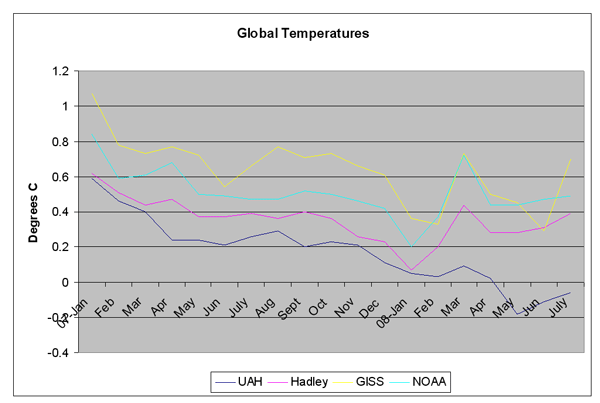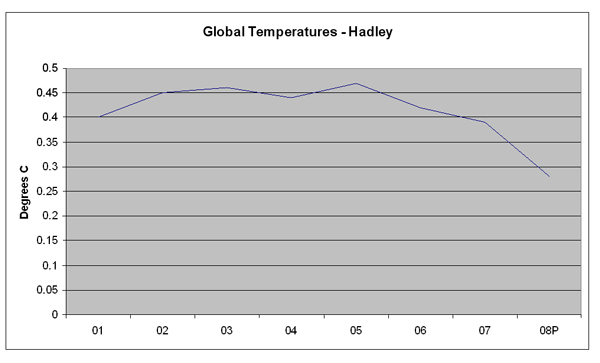One sceptic who is prepared to make a forecast, and who also points to the date of 2015, is professional UK weather forecaster Piers Corbyn. The bulk of scientists have little time for Corbyn, who is a strong advocate of the link between solar activity and climate. Greenhouse proponents, in particular, detest him. For as well as stridently denouncing the IPCC whenever he can, he also appeared on the documentary The Great Global Warming Swindle. However, he does have a track record as a weather forecaster and, for whatever reason, is saying the same things as the Keenlyside team, at least for the next few years. He forecasts that global temperatures will decline until 2015, and then kick up briefly, before declining again.
Whatever you may make of all this forecasting, a major problem remains working out what is happening right now, for the centres that track global climate say different things. There are five sites that I know of. Anyone who can think of others can message me on mlawson@afr.com.au. Of those five, three are instrument centres - relying on networks of ground stations and ships for temperature readings - and two are centres that use satellites to track temperatures. They are listed below, along with links to the data used in the graphs at the end of the article.
Hadley - Generally regarded as the most authoritative of the instrument centres. The Australian Bureau of Meteorology site links to the temperature tracks on the Hadley site. It is a part of the University of East Anglica in the UK and associated with the UK Meteorological Office, which are both IPCC bastions. The graphs use HADCrutv3.
Advertisement
GISS - Goddard Institute of Space Studies. A part of NASA. The director of this instrument centre is arch greenhouse spruiker Professor James Hansen. Greenhouse proponents always quote this centre’s temperatures for the annual results from this site are mysteriously higher than the others. Data for the graphs is here.
NOAA - National Oceanographic and Atmospheric Administration. Owned by the US Department of Commerce it is an instrument centre. Link for data here.
UAH - University of Alabama in Huntsville. A satellite centre run through the Earth System Science Centre. Director Dr John Christie is sometimes cited as a greenhouse agnostic, although he has contributed to several IPCC reports. The centre has shown temperatures trending down for years. Link here.
RSS - Remote Satellite Services. The site for this centre makes little sense to the laymen but from the graphs presented by scientists who have dealt with it, RSS surface temperature results are broadly similar to that of the UAH. I could not find any public access data for surface temperatures.
There are two graphs, produced using Excel. One is for temperature readings from four of the sites from January 2007 up to August and the other is for Hadley, as the mostly widely accepted, from 2001. As the IPCC third report was released in 2001 and the fourth report was released in February 2007, this should give us some idea of the forecasting success of the models. An interesting point in all of this is that NOAA and Hadley more or less agree (the difference is probably a difference in the base line the two sites use) but GISS shows a somewhat warmer world and the satellite results are markedly cooler than the others. However, none of the centres can point to anything but failure for the IPCC. There is still time for actual temperatures to bounce back to somewhere within the model forecasts but in the short term, at least, and on the only test that really matters for computer models - forecasting what was not known at the time of the report - the models have generally failed.
Given the track record of the existing models, and instead of generally rejecting the proposal that temperatures will remain subdued until 2015, greenhouse proponents should embrace the forecast - it is likely to be more accurate than any of the others made to date, particularly given the lack of solar activity. And we should all hurry towards 2014-2015 as fast as we can, to find out what happens.
Advertisement


Discuss in our Forums
See what other readers are saying about this article!
Click here to read & post comments.
117 posts so far.